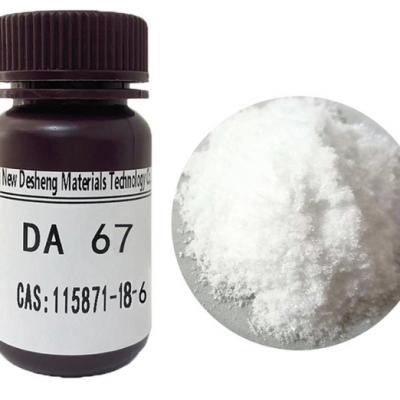Home > Products > Chromogenic substrate > Performance Characteristics and Usage Instructions of Color Developing Substrate DA67 115871-18-6
Performance Characteristics and Usage Instructions of Color Developing Substrate DA67 115871-18-6
- Shanghai
- T/T L/C
- 5 days
You May Like
-
Analysis of Luminol 521-31-3 Chemiluminescence Characteristics
-
Introduction and Precautions of Luminol Monosodium Salt 20666-12-0
-
Isoluminol Reagent for Chemiluminescence
-
Luminescence Analysis of High-purity Acridine Ester NSP-DMAE-NHS194357-64-7
-
Direct Chemiluminescence of Acridine Ester DMAE-NHS 115853-74-2
-
Detailed Introduction of Luminescent Reagent NSP-SA 211106-69-3
Product Details
| CAS No. | 115871-18-6 |
Product Description
As a water-soluble chromogenic reagent, DA67 not only has improved water solubility and sensitivity compared to traditional reagents, but also is simple and fast. Results can be obtained directly using a colorimeter, making it very suitable for the detection of biological component samples. Insiders have a clear understanding of it, but outsiders may not know much about it. Therefore, below is a general introduction to its characteristics and usage.
CHEMICAL
The chromogenic substrate DA67, with a CAS number of 115871-18-6 and a molecular weight of 408.45, appears as a white crystalline powder that is soluble in water. Its chromogenic reaction is usually produced by coordination with peroxidase. For the first time, DA67 is compatible with water solubility and high sensitivity. Previously, it was necessary to use luminescent or fluorescent reagents to achieve the goal, but now it can be done using DA67 without the need for other luminescent agents.
application area
Because it can directly obtain results using a colorimeter, it is suitable for detecting biological component samples, such as protein electrophoresis, nucleic acid electrophoresis, and other experiments as a substrate. By measuring the time of substrate consumption and changes in absorbance, information such as enzyme activity and substrate concentration can be reflected.
Performance characteristics
1. High sensitivity: DA67 has high sensitivity and can detect small changes in substrate consumption, which makes it widely used in biochemical experiments and molecular biology.
2. Good repeatability: The color reaction of DA67 has good repeatability and can be quantitatively analyzed through standardized methods, which makes the experimental results more accurate and reliable.
3. High water solubility: Traditional water-soluble color reagents, due to the low molecular absorption coefficient of color pigments, are prone to micro solubility that is difficult to handle. However, DA67 has high water solubility and can be directly dissolved in water at concentrations of 1mmol/L.
precautions
1. DA67 is easily affected by light and heat, so it is necessary to avoid prolonged exposure to air or high temperatures during storage and use. It is recommended to store it in a cool and dry place and use it as soon as possible.
2. The color reaction of DA67 is influenced by various factors, including substrate concentration, enzyme activity, reaction temperature, etc. Therefore, reasonable adjustments and controls need to be made according to experimental requirements during use.
3. When measuring the absorbance of DA67, it is necessary to calculate and select the appropriate detection wavelength to ensure the accuracy and reliability of the results, while also paying attention to calibrating the instrument and eliminating external interference.
As an advantageous supplier of chromogenic substrates, Desheng not only has DA67, but also products such as TOOS, TOPS, ADOS, ADPS, etc. Its sensitivity and reagent stability have been highly praised by customers. We are currently selling at a discounted price. If you are interested, please click on the website to inquire and purchase!
Contact Us

- Hubei New Desheng Material Technology Co., Ltd
- Contact nameDoris Yang Chat Now
Product Categories
| Additive for blood collection | Biological buffer | Chemiluminescence reagent | Chromogenic substrate |
| enzyme preparation |
New Products
-
Stability and Precautions of Acridine Ester (NSP-SA-NHS)
-
The Labeling Principle and Application of Acridine Hydrazide NSP-SA-ADH
-
Application and pH Stability of Acetyl CoA Oxidase
-
Tris and Glutamate Dehydrogenase Work Together on Homocysteine Assay Kit
-
The Relationship Between Purine Nucleoside Phosphorylase and Nucleic Acid Synthesis and Decomposition
-
Introduction of Desheng on Alpha Glucosidase
-
Glucose Dehydrogenase: a Key Enzyme in IVD in Vitro Diagnostic Reagents
-
Detailed Explanation of Storage Methods for Adenosine Deaminase (ADA)
-
Biological Functions and Applications of Malate Dehydrogenase
-
The Price of TRIS-HCL 1185-53-1 Produced by Desheng Has Been Lowered. Please Feel Free to Consult and Purchase
-
Why Should we Pay Attention to Solubility When Purchasing Biological Buffer TRIS 77-86-1?
-
The Effect of Purity of BICINE Powder 150-25-4 as a Biological Buffer on the Performance of Buffer Solutions
-
Introduction to the Transportation Packaging of CAPS Powder 1135-40-6, a Biological Buffering Agent
-
Compatibility of Biological Buffer MOPS 1132-61-2 With Other Reagents
-
Application of Biological Buffer TAPS 29915-38-6 in Enzyme Activity Research
-
The Advantage of High Purity of EPPS Powder 16052-06-5 Raw Materials for Biological Buffering Agents
-
Advantages of MOPSO Buffer 68399-77-9 in Low-temperature Biochemical Work
-
What Does HEPES Buffer 7365-45-9 do for Cell Culture
-
Application of Biological Buffer PIPES 5625-37-6 in Biochemical Research
-
How to Determine and Choose a BES Buffer 10191-18-1 Manufacturer for Procurement
-
Biological Buffer DIPSO (68399-80-4) Detailed Description for Quick Understanding
-
Multiple Applications of CHES Buffer in Biological Research
-
Advantages of High TOOS Molar Absorbance
-
How to Obtain High-quality TOPS Powder as a Chromogenic Substrate
Popular Searches
- sodium hypochlorite
- naclo
- hypochlorite
- calcium hypochlorite
- calcium salt
- potassium butyl xanthate
- calcium sodium
- sodium hypochlorite production
- sodium process
- granule sodium
- sodium hypochlorite water
- sodium 80% powder
- lime plastering
- sodium hypochlorite disinfection
- hypochlorite sodium
- sodium granular powder
- hypochlorite production
- electrolysis sodium hypochlorite
- swimming pool salt
- sea fish aquarium
- of calcium powder
- quotation sample
- aquarium coral
- emamectin benzoate wdg
- calcium price powder
- ptf
- aqua clear
- aquarium for sea water
- aquarium jellyfish
- aquarium white coral
Recommended Products
- Air and Environmental On-Site Testing Items Table
- Water Sample Mercury Ion (Hg²⁺) Concentration Assay Kit
- Nitrite Test Paper 0~100 Ppm
- On Site Rapid Detection of Surface Cleanliness of Catering Utensils
- Sodium Metasilicate Granular 25kg Powder
- Chlorine Dioxide Quick Test Kit
- Residual Chlorine Quick Test Kit
- Rapid Determination of Available Chlorine
- Quaternary Ammonium Sanitizer Concentration Test Strips [0~4000 Ppm]
- Quaternary Ammonium Sanitizer Concentration Test Strips [0~1000 Ppm]
- You Need to Pay Attention to These Three Erroneous Views When Purchasing Carbopol Powder
- Exploration of the Advantages of MAOS Chromogenic Substrates in Biochemical Detection
Find Similar Products By Category
- Chemicals > Chemical Reagent
- Please Enter your Email Address
- Please enter the content for your inquiry.
We will find the most reliable suppliers for you according to your description.
Send Now-
 Doris Yang
Hi there! Welcome to my shop. Let me know if you have any questions.
Doris Yang
Hi there! Welcome to my shop. Let me know if you have any questions.
Your message has exceeded the limit.

- Contact supplier for lowest price
- Customized Request
- Request Sample
- Request Free Catalogs
Your message has exceeded the limit.
-
Purchase Quantity
-
*Sourcing Details
Your inquiry content must be between 10 to 5000 characters.
-
*Email
Please enter Your valid email address.
-
Mobile




